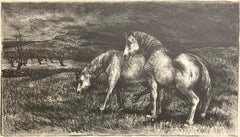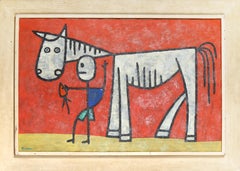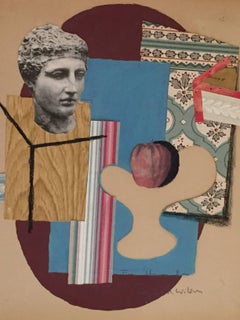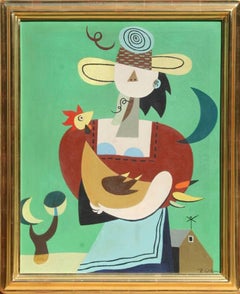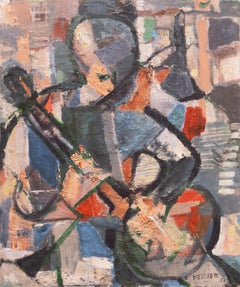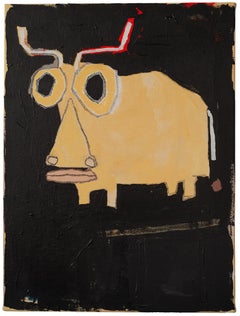Reginald Wilson Art
to
1
1
1
1
Overall Width
to
Overall Height
to
4
1
2
2
2
2
2
2
2
2
1
1
1
1
1
1
2
2
2
2
1
4
10,138
2,779
1,375
1,369
1
4
Artist: Reginald Wilson
Reginald Wilson, Horses
By Reginald Wilson
Located in New York, NY
Although this work is titled Horses. It nice to think it could be (Horses in a Field in Woodstock, NY), but it was printed by Will Barnet at the Art Students League, about 1938, and Wilson, who visited Woodstock with Arnold Blanche...
Category
1930s American Modern Reginald Wilson Art
Materials
Lithograph
Feeding the Horse a Carrot
By Reginald Wilson
Located in Long Island City, NY
Artist: Reginald Wilson, American (1909-1993)
Title: Feeding the Horse a Carrot
Year: Circa 1950
Medium: Oil on Canvas, signed l.r.
Size: 24 x 36 in. (60.96 x 91.44 cm)
Frame Size: 3...
Category
1950s Folk Art Reginald Wilson Art
Materials
Canvas, Oil
Modernist Collage
By Reginald Wilson
Located in Surfside, FL
Reginald Wilson was born in 1909 in the small town of Butler, Ohio. Determined from boyhood to be an artist, he arrived at the Art Students League of New York when he was twenty. He ...
Category
20th Century Modern Reginald Wilson Art
Materials
Mixed Media
Girl with Cock, Oil Painting by Reginald Wilson
By Reginald Wilson
Located in Long Island City, NY
Artist: Reginald Wilson, American (1909 - 1993)
Title: Girl with Cock
Year: circa 1950
Medium: Oil on Canvas, signed l.r.
Size: 30 x 24 inches (76.2 x 60.96 cm)
Frame: 33.5 x 28 inch...
Category
1950s Cubist Reginald Wilson Art
Materials
Canvas, Oil
Related Items
'Man Playing a Banjo', American Mid-Century Cubist-Derived Figural Oil, Fifties
Located in Santa Cruz, CA
Signed lower right, 'Paula Melcher' (American, 20th century) and dated 1956.
Category
1950s Cubist Reginald Wilson Art
Materials
Canvas, Oil
$1,500
H 24 in W 20 in D 0.75 in
Grass Fed
Located in Red Bank, NJ
Outsider artist Scott Harbison imagines a world of curious alien beings and wide-eyed mutant animals, naively navigating unknown territory. His mischievous figures are activated by s...
Category
21st Century and Contemporary Outsider Art Reginald Wilson Art
Materials
Canvas, Oil Crayon, Acrylic
Whimsical French Folk Art, Naive, Oil Painting Madeline Marie Christine Clavier
By Madeline Christine Clavier
Located in Surfside, FL
MADELINE CHRISTINE CLAVIER (1913-2015)
Signature: Signed lower right & titled verso
Medium: Oil on canvas
Provenance: The collection of the artist's family
Marie Christine Clavier was born in Saigon, Vietnam in 1913 to French parents and lived there for her formative years. She returned to France as a teenager and began to study painting. Her work quickly developed into whimsical paintings of poetry and songs – harmonized in a unique and distinct painting technique. Her work has an impasto feel and a folk art, outsider artist sensibility to it. Similar in style to Maik and other fantasy realists who use animals, flowers and foliage in their artworks. Marie Clavier painted ro herself rather than for profit as she was quite independently wealthy. She exhibited extensively in the United States in the 1970s especially across Connecticut and New York, showing at various galleries and cultural centres. She had numerous solo exhibitions in the 1970’s- notably at the Maison Francaise in New York and New York University. She showed at Galerie Bernheim Jeune in Paris. She won many awards for her work including Gold Medals and Palme D’Or medals. In 1988 the prestigious art publisher Leopard D’Or produced catalogue book on her life and work – by this point she had virtually given up painting. She died in 2015 aged 102.
Bernheim-Jeune gallery is one of the oldest art galleries in Paris. Opened on Rue Laffitte in 1863 by Alexandre Bernheim (1839-1915), friend of Delacroix, Corot and Courbet, it changed location a few times before settling on Avenue Matignon. The gallery promoted realists, Barbizon school paintings and, in 1874, the first impressionist and later post-impressionist painters. It closed in 2019. In 1901, Alexandre Bernheim, with his sons, Josse (1870-1941), and Gaston (1870-1953), organized the first important exhibition of Vincent van Gogh paintings in Paris with the help of art critic Julien Leclercq. In 1906, Bernheim-Jeune frères started presenting works by Pierre Bonnard, Edouard Vuillard, Paul Cezanne, Henri-Edmond Cross, Kees van Dongen, Henri Matisse, Le Douanier Rousseau, Raoul Dufy, Maurice de Vlaminck, Amedeo Modigliani, Maurice Utrillo and Georges Dufrenoy. From 1906 to 1925, art critic Félix Fénéon was the director of the gallery and was instrumental in bringing in the art of Georges Seurat and Umberto Boccioni.
In 1922, an exhibition brought together works by Alice Halicka, Auguste Herbin, Pierre Hodé, Moise Kisling, Marie Laurencin, Henri Lebasque, Fernand Leger and Henri Matisse. The gallery now exhibits painters and sculptors in the tradition of the École de Paris and artists such as Jean Carzou, Shelomo Selinger or Pollès.
Her style is a recognizable, cheerful, whimsical and a happy creation. Naïve art is any form of visual art that is created by a person who lacks the formal education and training that a professional artist undergoes (in anatomy, art history, technique, perspective, ways of seeing). Unlike folk art, naïve art does not necessarily evince a distinct cultural context or tradition. Naïve art is recognized, and often imitated, for its childlike simplicity and frankness. Paintings of this kind typically have a flat rendering style with a rudimentary expression of perspective.
One particularly influential painter of "naïve art" was Henri Rousseau (1844–1910), a French Post-Impressionist who was discovered by Pablo Picasso. Naïve art is often seen as outsider art that is by someone without formal (or little) training or degree. While this was true before the twentieth century, there are now academies for naïve art. Naïve art is now a fully recognized art genre, represented in art galleries worldwide. Museums devoted to naïve art now exist in Kecskemét, Hungary; Riga, Latvia; Jaen, Spain; Rio de Janeiro, Brasil; Vicq France and Paris. Another term related to (but not completely synonymous with) naïve art is folk art. There also exist the terms "naïvism" and "primitivism" which are usually applied to professional painters working in the style of naïve art (like Paul Gauguin, Mikhail Larionov, Paul Klee). At all events, naive art can be regarded as having occupied an "official" position in the annals of twentieth-century art since - at the very latest - the publication of the Der Blaue Reiter, an almanac in 1912. Wassily Kandinsky and Franz Marc, who brought out the almanac, presented 6 reproductions of paintings by le Douanier' Rousseau (Henri Rousseau), comparing them with other pictorial examples. However, most experts agree that the year that naive art was "discovered" was 1885, when the painter Paul Signac became aware of the talents of Henri Rousseau and set about organizing exhibitions of his work in a number of prestigious galleries. The Earth Group (Grupa Zemlja) were Croatian artists, architects and intellectuals active in Zagreb from 1929 to 1935. The group included the painters Krsto Hegedušić, Edo Kovačević, Omer Mujadžić, Kamilo Ružička, Ivan Tabaković, and Oton Postružnik, the sculptors Antun Augustinčić, Frano Kršinić, and the architect Drago Ibler. A term applied to Yugoslav (Croatian) naive painters working in or around the village of Hlebine, near the Hungarian border, from about 1930. Some of the best known naive artists are Dragan Gaži, Ivan Generalić, Josip Generalić, Krsto Hegedušić, Mijo Kovačić, Ivan Lacković-Croata, Franjo Mraz, Ivan Večenaj and Mirko Virius. Camille Bombois (1883–1970) Ferdinand Cheval, known as 'le facteur Cheval' (1836–1924) Henry Darger (1892–1973) L. S. Lowry (1887–1976) Grandma Moses, Anna Mary Robertson...
Category
20th Century Folk Art Reginald Wilson Art
Materials
Canvas, Oil
Scottish 20th Century naive oil painting of figures, dogs and birds in interior
Located in Petworth, West Sussex
Catriona Millar (Scottish, b. 1956)
Veva’s Guest
Oil on canvas
Signed with initials (lower left)
19.5/8 x 15.5/8 in. (50 x 39.7 cm.)
Catriona Millar (born 1956) is a Scottish figurative painter born in Milngavie, Glasgow. She studied at Grays School of Art, Aberdeen, where her tutors included Joyce Cairns RSA and Keith Grant...
Category
20th Century Folk Art Reginald Wilson Art
Materials
Canvas, Oil
$1,790
H 19.63 in W 15.63 in D 1 in
Tea at Sunset Vibrant Oil On Canvas
By Gregor Zamierowski
Located in Lake Worth Beach, FL
Tea at Sunset Vibrant Oil On Canvas,
Signed and title.
Born 1945 in Poland, lives and active in Canada.
His work was exhibited in galleries and Museums of Fine Arts in Canada.
Category
1980s Cubist Reginald Wilson Art
Materials
Canvas, Oil
Original 1919, Give the World The Once Over in the United States Navy poster
Located in Spokane, WA
Original 1919 Give The World The Once Over in the United States Navy vintage poster. Archival linen backed. This poster presents itself very fine condition. The lower text por...
Category
1910s American Modern Reginald Wilson Art
Materials
Lithograph
$2,998
H 42 in W 28.5 in D 0.05 in
The Owl that calls upon the Night speaks the Unbeliever's ...
By Leonard Baskin
Located in San Francisco, CA
This artwork titled "The Owl that calls upon the Night speaks the Unbeliever's" 1968 is an original woodcut on Makuroko paper by noted American artist Leonard Baskin, 1922-2000. It i...
Category
Mid-20th Century American Modern Reginald Wilson Art
Materials
Woodcut
$750
H 14.5 in W 12.5 in D 0.6 in
Outsider Art, Acrylic Painting: 'Grass Fed'
Located in New York, NY
Scott likes to think of his work as what it might look like if an overly observant 5 year old kid from New Jersey left hieroglyphics for alien life forms to discover. A mixture of ...
Category
2010s Outsider Art Reginald Wilson Art
Materials
Canvas, Oil Crayon, Acrylic
Acrylic Paint, Oil Stick on Cradled Panel: "I Picked Up Dinner"
Located in New York, NY
In 2018, I became a painter. An artist.
I am a product of the '70s and I spent my life in the fine state of New Jersey—the most wonderful state of them all.
As a result of stuff th...
Category
2010s Outsider Art Reginald Wilson Art
Materials
Canvas, Oil Crayon, Acrylic
$1,350
H 24 in W 18 in
Stag
By Leonard Baskin
Located in San Francisco, CA
This artwork titled "Stag" 1957 is an original woodcut on laid paper by noted American artist Leonard Baskin, 1922-2000. It is hand signed and inscribed A.P. (Artist Proof) pencil by...
Category
Mid-20th Century American Modern Reginald Wilson Art
Materials
Woodcut
Alexander Calder Circus Reproduction Lithograph After a Drawing
By (after) Alexander Calder
Located in Surfside, FL
(after) Alexander Calder
"Calder's Circus" offset lithograph on wove paper after drawings by the artist
Published by Art in America and Perls gallery in 1964 (from drawings done in the 1930's)
these range slightly in size but they are all about 13 X 17 inches (with minor variations in size as issued.) These have never been framed. The outer folio is not included just the one lithograph.
James Sweeny from the introduction “The fame of Calder’s circus spread quickly between the years 1927 and 1930. All the Paris art world came to know it. It brought him his first great personal success. But what was more important, the circus also provided the first steps in Calder’s development as an original sculptor”
Clive Gray wrote ”A visit to the studio of Alexander Calder led to the chance discovery of some hundred masterful circus drawings completed over thirty years ago. We publish, for the first time, a choice of sixteen from that group.” With signed introduction by Miro.
These whimsical drawings, done in the style of wire sculpture, include acrobats, clowns, jugglers, trapeeze artists, an elephant, dog and lion. they are great.
Alexander Calder is widely considered to be one of the most important American sculptors of the 20th century. He is best known for his colorful, whimsical abstract public sculptures and his innovative mobiles, kinetic sculptures powered by motors or air currents, which embraced chance in their aesthetic. Born into a family of accomplished artists, Calder's work first gained attention in Paris in the 1930s and was soon championed by the Museum of Modern Art in New York, resulting in a retrospective exhibition in 1943. Major retrospectives were also held at the Solomon R. Guggenheim Museum (1964) and the Museum of Contemporary Art, Chicago (1974). Calder’s work is in many permanent collections, most notably in the Whitney Museum of American Art, but also the Guggenheim Museum; the Museum of Modern Art; the National Gallery of Art, Washington, D.C.; and the Centre Georges Pompidou. He produced many large public works, including .125 (at JFK Airport, 1957), Pittsburgh (Carnegie International prize winner 1958, Pittsburgh International Airport) Spirale (UNESCO in Paris, 1958), Flamingo and Universe (both in Chicago, 1974), and Mountains and Clouds (Hart Senate Office Building, Washington, D.C., 1976). Although primarily known for his sculpture, Calder was a prodigious artist with a restless creative spirit, whose diverse practice included painting and printmaking, miniatures (such as his famous Cirque Calder), children’s book illustrations, theater set design, jewelry design, tapestry and rug works, and political posters. Calder was honored by the US Postal Service with a set of five 32-cent stamps in 1998, and received the Presidential Medal of Freedom, posthumously in 1977, after refusing to receive it from Gerald Ford one year earlier in protest of the Vietnam War.
Calder moved to New York and enrolled at the Art Students League, studying briefly with Thomas Hart Benton, George Luks, Kenneth Hayes Miller, and John Sloan. While a student, he worked for the National Police Gazette where, in 1925, one of his assignments was sketching the Ringling Bros. and Barnum & Bailey Circus. Calder became fascinated with the action of the circus, a theme that would reappear in his later work.
In 1926, Calder moved to Paris, enrolled in the Académie de la Grande Chaumière, and established a studio at 22 rue Daguerre in the Montparnasse Quarter. In June 1929, while traveling by boat from Paris to New York, Calder met his future wife, Louisa James (1905-1996), grandniece of author Henry James and philosopher William James. They married in 1931. While in Paris, Calder met and became friends with a number of avant-garde artists, including Fernand Léger, Jean Arp, and Marcel Duchamp. Cirque Calder (on view at the Whitney Museum of American Art at present) became popular with the Parisian avant-garde. He also invented wire sculpture, or "drawing in space," and in 1929 he had his first solo show of these sculptures in Paris at Galerie Billiet. Hi! (Two Acrobats) in the collection of the Honolulu Museum of Art is an early example of the artist's wire sculpture. The painter Jules Pascin, a friend of Calder's from the cafes of Montparnasse, wrote the preface to the catalog. A visit to Piet Mondrian's studio in 1930, where he was impressed by the environment-as-installation, "shocked" him into fully embracing abstract art, toward which he had already been tending.
Dating from 1931, Calder’s sculptures of discrete movable parts powered by motors were christened “mobiles” by Marcel Duchamp, a French pun meaning both "motion" and "motive." At the same time, Calder was also experimenting with self-supporting, static, abstract sculptures, dubbed "stabiles" by Jean Arp in 1932 to differentiate them from mobiles.
Public commissions increasingly came his way in the 1960s. Notable examples are .125 for JFK Airport in 1957, Spirale for UNESCO in Paris 1958 and Trois disques, commissioned for Expo 67 in Montreal, Quebec, Canada. Calder's largest sculpture at 25.7 meters high was El Sol Rojo, constructed outside the Aztec Stadium for the 1968 Summer Olympics "Cultural Olympiad" events in Mexico City. Many of his public works were commissioned by renowned architects; I.M. Pei commissioned his La Grande Voile (1966), a 25-ton, 40-foot high stabile for the Massachusetts Institute of Technology.
Part of Calder's repertoire includes pivotal stage sets for more than a dozen theatrical productions, including Nucléa, Horizon, and most notably, Martha Graham’s Panorama (1935), a production of the Erik Satie symphonic drama Socrate (1936), and later, Works in Progress (1968).
In addition to sculptures, Calder painted throughout his career, beginning in the early 1920s. He picked up his study of printmaking in 1925, and continued to produce illustrations for books and journals.As Calder’s professional reputation expanded in the late 1940s and 1950s, so did his production of prints. Masses of lithographs based on his gouache paintings hit the market, and deluxe editions of plays, poems, and short stories illustrated with fine art prints by Calder became available for sale.
One of Calder's most celebrated and unconventional undertakings was a commission from Dallas-based Braniff International Airways to paint a full-size Douglas DC-8-62 four-engined jet as a "flying canvas."
Calder created over 2,000 pieces of jewelry over the course of his career, many of them as gifts for friends and relatives. For his lifelong friend Joan Miró, he set a shard of a broken porcelain vessel in a brass ring. Peggy Guggenheim received enormous silver mobile earrings and later commissioned a hammered silver headboard...
Category
1930s American Modern Reginald Wilson Art
Materials
Lithograph
COCOA CAT original painting
By Daria Kusto
Located in CÓRDOBA, ES
Original painting by Daria Kusto.
Acrylic on canvas.
Painting rolled in a sturdy tube.
Shipping from Spain, safely and promptly.
Category
2010s Folk Art Reginald Wilson Art
Materials
Canvas, Acrylic
Previously Available Items
Modernist Collage
By Reginald Wilson
Located in Surfside, FL
Reginald Wilson was born in 1909 in the small town of Butler, Ohio. Determined from boyhood to be an artist, he arrived at the Art Students League of New York when he was twenty. He studied with John Stuart Currie, among others, meanwhile making a living with odd jobs like that of office boy or night watchman. He was an easel painter in the Federal Art Project and served for three years as an airplane mechanic in the US Army Air Force during World War II. He and the artist Carolyn Haeberlin were married in 1942, moving in 1945 to where they made their home in a 200-year-old farmhouse.
Wilson’s paintings and works in other media were exhibited widely beginning in the 1940’s, in New York City and in major museums and universities across the country. In Woodstock he showed at a number of galleries including that of the Woodstock Artists Association where he won the 1973 Sally Jacobs-Phoebe Towbin Award.
His mid-Twentieth century contemporaries included Karl Fortess...
Category
20th Century Modern Reginald Wilson Art
Materials
Mixed Media
Minimal Contemporary Still Life Painting
By Reginald Wilson
Located in Houston, TX
Minimal orange and blue contemporary abstract still life painting. The work is done by artist Reginald Wilson.
Dimensions Without Frame: H 12 in x W 8 in.
Artist Biography: Reginal...
Category
20th Century Minimalist Reginald Wilson Art
Materials
Acrylic
Cat and Birds
By Reginald Wilson
Located in Long Island City, NY
Artist: Reginald Wilson, American (1909-1993)
Title: Cat and Birds
Year: Circa 1950
Medium: Oil on Canvas, signed l.r.
Size: 36 x 30 in. (91.44 x 76.2...
Category
1950s Folk Art Reginald Wilson Art
Materials
Canvas, Oil
Modernist Collage
By Reginald Wilson
Located in Surfside, FL
Reginald Wilson was born in 1909 in the small town of Butler, Ohio. Determined from boyhood to be an artist, he arrived at the Art Students League of New York when he was twenty. He studied with John Stuart Currie, among others, meanwhile making a living with odd jobs like that of office boy or night watchman. He was an easel painter in the Federal Art Project and served for three years as an airplane mechanic in the US Army Air Force during World War II. He and the artist Carolyn Haeberlin were married in 1942, moving in 1945 to where they made their home in a 200-year-old farmhouse.
Wilson’s paintings and works in other media were exhibited widely beginning in the 1940’s, in New York City and in major museums and universities across the country. In Woodstock he showed at a number of galleries including that of the Woodstock Artists Association where he won the 1973 Sally Jacobs-Phoebe Towbin Award.
His mid-Twentieth century contemporaries included Karl Fortess...
Category
20th Century Modern Reginald Wilson Art
Materials
Mixed Media
Reginald Wilson art for sale on 1stDibs.
Find a wide variety of authentic Reginald Wilson art available for sale on 1stDibs. You can also browse by medium to find art by Reginald Wilson in canvas, fabric, oil paint and more. Much of the original work by this artist or collective was created during the 20th century and is mostly associated with the modern style. Not every interior allows for large Reginald Wilson art, so small editions measuring 14 inches across are available. Customers who are interested in this artist might also find the work of Cecil Crosley Bell, Arthur Osver, and William Harnden. Reginald Wilson art prices can differ depending upon medium, time period and other attributes. On 1stDibs, the price for these items starts at $500 and tops out at $50,000, while the average work can sell for $7,600.
